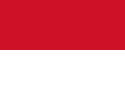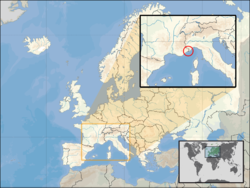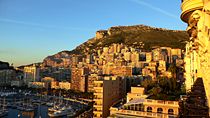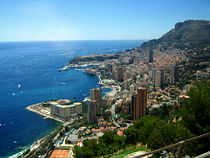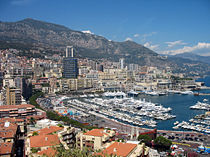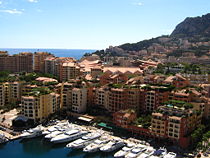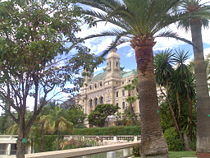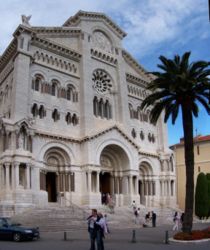Monaco
2008/9 Schools Wikipedia Selection. Related subjects: Europe; European Countries
| Principauté de Monaco Principality of Monaco
|
||||||
|---|---|---|---|---|---|---|
|
||||||
| Motto: "Deo Juvante" (Latin) "With God's Help" |
||||||
| Anthem: Hymne Monégasque |
||||||
|
Location of Monaco (circled in inset)
on the European continent (white) |
||||||
| Capital | Monaco | |||||
| Largest Most populated quartier |
Monte Carlo |
|||||
| Official languages | French | |||||
| Demonym | Monégasque or Monagasque | |||||
| Government | Constitutional monarchy and Principality | |||||
| - | Prince | Albert II | ||||
| - | Minister of State | Jean-Paul Proust | ||||
| - | President of the National Council | Stéphane Valeri ( UPM) | ||||
| Independence | ||||||
| - | House of Grimaldi | 1297 | ||||
| Area | ||||||
| - | Total | 1.95 km² ( 233rd) 0.76 sq mi |
||||
| - | Water (%) | 0.0 | ||||
| Population | ||||||
| - | 2007 estimate | 32,671 ( 210th) | ||||
| - | 2000 census | 32,020 | ||||
| - | Density | 16,754/km² ( 2nd) 47,358/sq mi |
||||
| GDP ( PPP) | 2007 estimate | |||||
| - | Total | $976 million ( ?) | ||||
| - | Per capita | $70,670 (€50,000) (Mid Sept. 07 est.) ( 2/3) | ||||
| HDI (2003) | n/a (n/a) ( unranked) | |||||
| Currency | Euro ( EUR) |
|||||
| Time zone | CET ( UTC+1) | |||||
| - | Summer ( DST) | CEST ( UTC+2) | ||||
| Internet TLD | .mc | |||||
| Calling code | +377 | |||||
Monaco, officially the Principality of Monaco ( Monégasque: Principatu de Múnegu; Occitan: Principat de Mónegue; French: Principauté de Monaco) is a small sovereign city-state located in Western Europe. The territory lies on the northern coast of the Mediterranean Sea and is completely enclosed by France. Monaco is often regarded as a tax haven, and many of its inhabitants are wealthy and from foreign countries (including France), although they are not a majority.
Monaco is a Constitutional Monarchy and Principality with Prince Albert II as head of state. The Grimaldi family has ruled over Monaco since 1292 and the state's sovereignty was officially recognized by the Franco-Monegasque Treaty of 1861. Despite being independent, Monaco’s defense is still the responsibility of France.
Monaco is the world’s most densely populated sovereign country, and the world's smallest French-speaking country.
Administrative division
Monaco is a small country in Europe, and the distinction between the State and City of Monaco is purely theoretical. The state in fact consists of one municipality (commune) only. According to the constitution of 1911, the principality was subdivided into three municipalities:
- Monaco ( Monaco-Ville), the old city on a rocky promontory extending into the Mediterranean, known as the Rock of Monaco, or simply le Rocher (the rock), where the palace is located
- Monte Carlo, the principal residential and resort area with the Monte Carlo Casino in the east and northeast
- La Condamine, the northwest section including the port area.
The three municipalities were merged into one in 1954 (after accusations that the government was acting according to the motto "divide and conquer"), and they had the status of wards (quartiers) thereafter.
- Fontvieille was added as fourth ward, a newly constructed area reclaimed from the sea (in the 1970s)
- Moneghetti became the fifth ward, created from a part of La Condamine
- Larvotto became the sixth ward, created from a part of Monte Carlo
- La Rousse/Saint Roman (including Le Ténao) became the seventh ward, also created from a part of Monte Carlo
Subsequently, three additional wards were created:
- Saint Michel, from a part of Monte Carlo
- La Colle, from a part of La Condamine
- Les Révoires, from a part of La Condamine
An additional ward is planned by new land reclamation, to be settled from 2014:
- Le Portier
Currently the principality is subdivided into 10 wards (with their official numbers - Le Portier, the planned ward, is anticipated as number 11):
| Nr | Ward | Area (m²) |
Population ( Census of 2000) |
Density km−2 |
City Blocks (îlots) |
Remarks |
|---|---|---|---|---|---|---|
| Former municipality of Monaco | ||||||
| 05 | Monaco-Ville | 184,750 | 1,034 | 5597 | 19 | Old City with palace |
| Former municipality of Monte Carlo | ||||||
| 01 | Monte Carlo/Spélugues (Bd. Des Moulins-Av. de la Madone) | 281,461 | 3,034 | 10779 | 20 | the casino and resort area |
| 02 | La Rousse/ Saint Roman (Annonciade-Château Périgord) | 105,215 | 3,223 | 30633 | 15 | in the northeast, incl. Le Ténao |
| 03 | Larvotto/Bas Moulins (Larvotto-Bd Psse Grace) | 328,479 | 5,443 | 16570 | 15 | eastern beach area |
| 10 | Saint Michel (Psse Charlotte-Park Palace) | 142,223 | 3,807 | 26768 | 24 | central residential area |
| Former municipality of La Condamine | ||||||
| 04 | La Condamine | 237,283 | 3,847 | 16213 | 27 | port area in the northwest |
| 07 | La Colle (Plati-Pasteur-Bd Charles III) | 188,073 | 2,822 | 15005 | 15 | on the western border with Cap d'Ail |
| 08 | Les Révoires (Hector Otto-Honoré Labande) | 75,747 | 2,515 | 33203 | 11 | containing the Jardin Exotique |
| 09 | Moneghetti/ Bd de Belgique (Bd Rainier III-Bd de Belgique | 107,056 | 3,003 | 28051 | 18 | |
| new land reclaimed from the sea | ||||||
| 06 | Fontvieille | 324,157 | 3,292 | 10156 | 9 | started 1971 |
| 11 | Le Portier | 275,0001) | - | - | - | planned (for 2014) |
| Monaco | 1,974,444 | 32,020 | 16217 | 173 | ||
| 1) Area not included in total, as it is only proposed | ||||||
For statistical purposes, the wards of Monaco are further subdivided into 173 city blocks (îlots), which are comparable to the census blocks in the United States.
History
Monaco first gained its name from the nearby Phocaean Greek colony, in the sixth century BC, which referred to the Ligurians as Monoikos, from the Greek Μόνοικος "single house", from μόνος "alone, single" + οίκος "house", which bears the sense of a people either settled in a "single habitation" or of "living apart" from others. According to an ancient myth, Hercules passed through the Monaco area and turned away the previous gods. As a result a temple was constructed there by Phocaeans, the temple of Hercules Monoikos. Because the only temple of this area was the "House" of Hercules, the city was called Monoikos.
Following a land grant from Emperor Henry VI in 1191, Monaco was re-founded in 1228 as a colony of Genoa. Monaco has been ruled by the House of Grimaldi since 1297, when François Grimaldi ("Malizia", Italian for "The Malicious") and his men captured the fortress protecting the famous Rock of Monaco while he was dressed as a Franciscan monk – or, in Italian Monaco, although this is a coincidence as the area was already known by this name.
From 1793 to 1814, Monaco was under French control. The Congress of Vienna designated Monaco as a protectorate of the Kingdom of Sardinia from 1815 until 1860 when the Treaty of Turin ceded to France the surrounding county of Nice (as well as Savoy). During this time there was unrest in the towns of Menton and Roquebrune, which declared independence, hoping for annexation by Sardinia. The unrest continued until the ruling prince gave up his claim to the two towns (some 95% of the country), and they were ceded to France in return for four million francs. This transfer and Monaco's sovereignty was recognised by the Franco-Monegasque Treaty of 1861.
Until the 1911 constitution, the princes of Monaco were absolute rulers. In July 1918, a treaty was signed providing for limited French protection over Monaco. The treaty, part of the Treaty of Versailles, established that Monegasque international policy would be aligned with French political, military, and economic interests.
In 1943, the Italian army invaded and occupied Monaco, setting up a Fascist administration. Shortly thereafter, following Mussolini's collapse in Italy, the Nazi German Wehrmacht occupied Monaco and began the deportation of the Jewish population. Among them was René Blum (Paris, 13 March 1878 - Auschwitz, 30 April 1943), who founded the Ballet de l'Opera in Monte Carlo. He was held in the Drancy deportation camp outside of Paris, France from where he was then shipped to the Auschwitz concentration camp where he died.
Rainier III, Prince of Monaco acceded to the throne following the death of his grandfather, Prince Louis II, in 1949. A new constitution, proclaimed in 1962, abolished capital punishment, provided for women's suffrage, and established a Supreme Court of Monaco to guarantee fundamental liberties. In 1993, the Principality of Monaco became a member of the United Nations, with full voting rights.
In 2002, a new treaty between France and Monaco specified that, should there be no heirs to carry on the Grimaldi dynasty, the principality would still remain an independent nation rather than revert to France. Monaco's military defense, however, is still the responsibility of France.
On 31 March 2005, Prince Rainier III, too ill to exercise his duties, relinquished them onto his only son and heir, Prince Albert Alexandre Louis. Prince Rainier died on 6 April 2005, after a reign of fifty-six years, and his son succeeded him as Albert II, Sovereign Prince of Monaco.
Following a period of official mourning, Prince Albert II formally assumed the princely crown on 12 July 2005, in a celebration that began with a solemn Mass at Monaco cathedral, where his father had been buried three months earlier. His accession to the Monegasque throne was a two-step event, with a further ceremony, drawing heads of state for an elaborate levée, held on 19 November 2005 at the historic palace in Monaco-Ville. Albert II is also the son of the late princess Grace, once the actress, Grace Kelly.
Law and government
Monaco has been governed as a constitutional monarchy since 1911, with the Sovereign Prince of Monaco as Head of state. The executive branch consists of a Minister of State (the head of government), who presides over a four-member Council of Government (the Cabinet). The minister of state is a French citizen appointed by the prince from among candidates proposed by the French government. Under the 1962 constitution, the prince shares his power with the unicameral National Council (parliament). The twenty-four members of this legislative body are elected from lists by universal suffrage for five-year terms. The principality's local affairs are directed by the Communal Council, which consists of fifteen elected members and is presided over by the mayor.
Economy
One of Monaco's main sources of income is tourism; each year many are attracted to its casino and pleasant climate. In 2001, a major new construction project extended the pier used by cruise ships in the main harbour. The principality has successfully sought to diversify into services and small, high-value-added, non-polluting industries such as cosmetics and biothermics.
The state retains monopolies in numerous sectors, including tobacco and the postal service. The telephone network ( Monaco Telecom) used to be owned by the state; it now owns 45%, while the remaining 55% is owned by Cable and Wireless (49%) and Compagnie Monégasque de Banque (6%). It is still, however, a monopoly. Living standards are high, roughly comparable to those in prosperous French metropolitan areas.
Monaco is not a member of the European Union but is very closely linked to it via a customs union with France, and as such its currency is the same as that of France: the euro. Prior to 2002, Monaco minted their own franc coins, the Monegasque franc. Monaco has acquired the right to mint euro coins with Monegasque designs on their national side.
Tax haven
The State has no income tax for individuals. The lack of personal income tax has led to a considerable number of wealthy "tax refugee" residents from European countries who derive the majority of their income from activity outside Monaco; celebrities such as Formula One drivers attract most of the attention, but the vast majority of them are considerably less well-known business people.
In 2000, a report by French parliamentarians Arnaud Montebourg and Vincent Peillon alleged that Monaco has lax policies with respect to money laundering, including within its famed casino, and that the government of Monaco puts political pressure on the judiciary so that alleged crimes are not properly investigated.
The Organisation for Economic Co-operation and Development ( OECD) issued in 1998 a first report on the consequences of the tax havens financial systems. Monaco did not appear in the list of these territories until 2004, when OECD became indignant regarding the Monegasque situation and denounced it in its last report (as well as Andorra, the Principality of Liechtenstein, Liberia and the Republic of the Marshall Islands) underlining its lack of co-operation as regards financial information disclosure and availability.
In 2000, the Financial Action Task Force ( FATF) underlined that Monaco suffers a great lack of adequate resources. The Principality is no longer blamed in the FATF 2005 report, as well as all other territories in 2006.
Since 2003, the International Monetary Fund ( IMF) has identified Monaco, along with 36 other territories, as a tax haven.
The Council of Europe also decided to issue reports naming tax havens. 22 territories, Monaco included, were thus evaluated between 1998 and 2000 on a first round. Monaco is the only territory that refuses to perform the second round, initially forecast between 2001 and 2003, whereas the 21 other territories are implementing the third and last round, planned between 2005 and 2007.
Geography of Monaco
Monaco is completely bordered by France to the north, west, and south; to the east it is bordered by the Mediterranean Sea.
Sport
Football
Football in Monaco is overwhelmingly dominated by AS Monaco FC, a club which plays in the French League, which they have won on seven occasions. The club plays their games at the Stade Louis II.
There is also a Monaco national football team who play matches against other small nations, islands and dependencies. They are currently seeking membership of FIFA which would allow them to try and qualify for the FIFA World Cup.
Every year Monaco plays host to the UEFA Super Cup and the draw for the UEFA Champions League.
Monaco Grand Prix
Since 1929, the Monaco Grand Prix has been held annually in the streets of Monaco. It is widely considered to be one of the most prestigious automobile races in the world, along with the Indianapolis 500 and the 24 Hours of Le Mans. The erecting of the circuit takes six weeks to complete, and the removal after the race another three weeks. The circuit has many elevation changes and tight corners, along with a tunnel. This together with being incredibly narrow make it perhaps the most demanding Formula One track. Only two drivers have ever crashed into the harbour, the most famous being Alberto Ascari in 1955 (Ascari would lose his life four days later at Monza). The other was Paul Hawkins during the 1965 race.
Monte Carlo Rally
The Monte Carlo Rally has been held since 1911, having originally been held at the behest of Albert I, Prince of Monaco, and is, like the principality's Grand Prix, organised by the Automobile Club de Monaco. It has long been considered to be one of the toughest and most prestigious events in rallying and since 1973 has been the opening round of the World Rally Championship.
Other Sports
The Monte Carlo Masters is currently held annually in neighbouring Roquebrune-Cap-Martin, France, as a professional tournament for men as part of tennis' ATP Masters Series. The tournament has been held since 1897. Golf's Monte Carlo Open was also held at the Monte Carlo Golf Club at Mont Agel in France between 1984 and 1992.
Education
Primary and secondary schools
Monaco has ten state-operated schools, including seven nursery and primary schools, one secondary school ( Collège Charles III), one lycée that provides general and technological training ( Lycée Albert 1er), and one lycée that provides vocational and hotel training. There are also two grant-aided denominational private schools (including Institution François d'Assise Nicolas Barré) and (Ecole des Sœurs Dominicaines) and one international school (International School of Monaco).
Colleges and universities
- International University of Monaco
Demographics
Monaco's population is unusual in that the native Monegasques are a minority in their own country. The largest proportion of residents are French nationals (47%), followed by Monegasque (16%), and Italians (16%). The remaining 21% belong to one of the other 125 nationalities that make up Monaco's international population.
Languages
French is the only official language, but Italian, English, and the two local languages, Monégasque (a local variety of Ligurian) and Occitan, are also spoken. The literacy rate is 99%.
The Monégasque language is expected to experience a revival in the near future following a recent decision to teach it to all children in Monaco's schools.
Religion
Roman Catholic
The official religion is Roman Catholicism, with freedom of other religions guaranteed by the constitution. There are five Catholic parish churches in Monaco and one cathedral presided over by an archbishop.
Anglican
There is one Anglican church ( St. Paul's Church), located in the Avenue de Grande Bretagne in Monte Carlo. In 2007 this had a formal membership of 135 Anglicans resident in the principality, but was also serving a considerably larger number of Anglicans temporarily in the country, mostly as tourists. The church site also accommodates an English-language library of over 3,000 books.
Jewish
The Association Culturelle Israelite de Monaco (founded 1948) is a house that has been converted into a synagogue, a community Hebrew school, and kosher food shop, located in Monte Carlo. There are weekly services on Shabbat. Several organizations, including WIZO and B’nai B’rith, are active in the Jewish community of Monaco. The community (approximately 1,500 strong) is mainly retired Jews from Britain (40%) and North Africa. There are also several Turkish and French Ashkenazi families. Half the population is Ashkenazi, while the other half are Sephardic.
Security
The wider defence of the nation is provided by France.
Monaco has no navy or air force, but on both a per-capita and per-area basis, Monaco has the largest police force (515 police officers for 32,000 people) and police presence in the world. Its police includes a specialist unit which operates patrol and surveillance boats. There is also a small military consisting of a (mainly ceremonial) bodyguard unit for the Prince and his palace called the Compagnie des Carabiniers du Prince which numbers 112 officers and men and is equipped with modern weapons such as M-16 rifles and 9 mm pistols, and a militarized (and armed) fire and civil defence Corps.
The Compagnie des Carabiniers du Prince (Prince's Company of Carabiniers) is the main ceremonial unit of the military force of Monaco. It was created by Prince Honoré IV in 1817 for the protection of the Principality and the Princely family. The company numbers exactly 121 officers and men; while the NCOs and soldiers are local, the officers have generally served in the French Army. Together with the local fire service, the Carabiniers form Monaco's total public forces. In addition to their guard duties, the company patrols the Principality's beaches and coastal waters, as well as duties around the Palace in Monaco-Ville.
Flag
The flag of Monaco reflects the heraldic colours of the Grimaldi family. It is one of the world's oldest national flag designs. The flag of Monaco is identical to that of Indonesia (except for the ratio of height to width).
Transport
Several train systems serve Monaco.
The closest airport is Cote d'Azur Airport in Nice, France. Some airlines marketed Monaco via Nice Airport.
